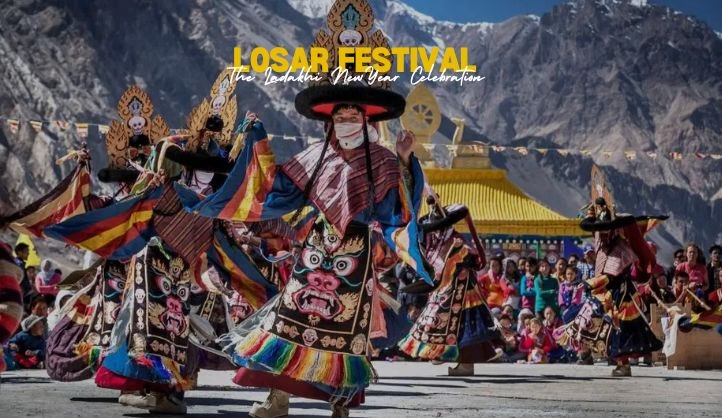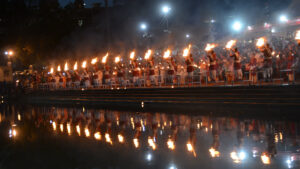Losar, derived from the Tibetan words “Lo” meaning “year” and “Sar” meaning “new,” refers to the Tibetan New Year, marking the beginning of a fresh lunar cycle. It is a significant celebration for the Ladakhi people, deeply embedded in their culture, spirituality, and daily life. This festival brings joy, renewal, and spiritual growth, welcoming good fortune for the year ahead.
Losar is a time to say goodbye to the challenges of the past year, offering a chance for spiritual reflection and growth. The festival is rooted in Ladakh’s Buddhist traditions and marks a period of cleansing negative energies while embracing positive change.
When is Losar Celebrated in Ladakh?
The exact date of Losar varies each year, as it follows the lunar calendar. Typically celebrated in late January or February, it begins on the first new moon after the winter solstice. It lasts for 15 days, but the first three days are the most important and widely celebrated.
Where is Losar Celebrated?
It is celebrated throughout Ladakh, a region in the northern part of India. While it is a Tibetan festival, it is also embraced by Ladakhis, who follow Tibetan Buddhism. The festival is celebrated in homes, monasteries, and communities across Ladakh, from Leh to the remote villages, where people gather to take part in various traditions and rituals. It is also celebrated by Ladakhi diaspora communities around the world.
The Spiritual Significance of Losar in Ladakh
It holds deep spiritual meaning for the Ladakhi people. It’s a time when the forces of nature and spirits are believed to be more receptive to prayers and offerings. During this period, rituals and spiritual practices are performed to purify the soul, remove obstacles, and invite prosperity, peace, and good health into life.
The celebration is not just about fun and festivities but also about spiritual renewal, offering prayers for blessings in the year to come. People connect with their Buddhist beliefs through meditation, visiting monasteries, and receiving blessings from monks.
Traditions and Rituals of Losar in Ladakh
The celebrations of Losar in Ladakh are marked by a variety of colorful and meaningful traditions:
House Cleaning and Decorations:
Leading up to Losar, families clean their homes to clear away negative energy. Homes are decorated with prayer flags, flowers, and symbolic items that invite good fortune for the year ahead.
Offerings and Prayers:
Ladakhis visit monasteries and temples to offer prayers and food to the gods, seeking blessings for health, prosperity, and happiness. Many people make offerings of butter lamps and light candles to bring warmth and light into their lives.
Cham Dance:
Monks perform Cham dances in monasteries, wearing colorful costumes and masks. These traditional dances symbolize the triumph of good over evil and are believed to bring spiritual purification and protection.
Exchanging Gifts and Greetings:
It’s customary to visit family and friends, exchange gifts, and greet one another with the phrase “Tashi Delek,” which means “Good Luck” or “Blessings.” It is a time for sharing and spreading good wishes.
The History and Legends Behind Losar
It has ancient roots, initially celebrated as a festival for the winter solstice in Tibet. The celebration evolved with the spread of Buddhism, and in Ladakh, it came to represent both the new year and a time for spiritual cleansing.
A popular legend tells of a demon who caused suffering and misfortune among the people. The demon was defeated by a wise king with the help of Buddhist monks. Since then, it has symbolized the victory of good over evil and the removal of obstacles for a prosperous year.
Special Losar Foods: A Feast of Tradition
Food plays a significant role in these celebrations in Ladakh. Traditional dishes carry symbolic meaning and bring people together to celebrate the new year:
Guthuk:
A special noodle soup is eaten on the eve of Losar. The soup contains dumplings with hidden ingredients that predict one’s fortune for the year. For example, finding a coin is believed to bring wealth, while a chili may suggest challenges ahead.
Khapse:
Fried biscuits shaped in various patterns, are often served as snacks or gifts. Khapse symbolizes prosperity, happiness, and abundance.
Chang (Barley Beer):
A traditional fermented barley drink enjoyed during Losar. Homemade and shared with family and friends, it symbolizes community and togetherness.
Losar and Tibetan Buddhism in Ladakh
In Ladakh, It is deeply connected to Tibetan Buddhism. Monks, families, and communities visit monasteries to pray, meditate, and seek spiritual guidance. For many, it is a time for self-purification, making vows to improve their lives and offering gratitude for the blessings of the past year.
How Losar Differs from Other Lunar New Year Celebrations
While it shares similarities with other Lunar New Year festivals, such as the Chinese New Year, it has a distinct focus on spiritual renewal. The primary difference lies in the strong Buddhist influence and the emphasis on purification and blessings for the coming year. In contrast to other celebrations, which are often more centered on family gatherings and festivities, Losar in Ladakh also emphasizes deep spiritual practices.
Why You Should Join Losar Celebrations
Joining this celebration in Ladakh offers a unique opportunity to experience the region’s warmth and hospitality. Whether you’re watching the colorful Cham dance, visiting a monastery for blessings, or enjoying traditional foods, it is a culturally rich experience. It’s a time to reflect, renew, and connect with the community spirit of Ladakh. It is the perfect event to witness if you’re interested in learning more about Ladakhi culture or seeking a meaningful celebration.
Conclusion: The Spirit of Losar
Losar in Ladakh is more than just a New Year celebration, it is a time of joy, renewal, and spiritual reflection. With its beautiful traditions, community gatherings, and heartfelt rituals, it offers a unique glimpse into Ladakhi culture. Whether you’re participating in the dances, enjoying the food, or receiving blessings for the year ahead, it leaves a lasting impression of hope, warmth, and positivity.
FAQs About Losar in Ladakh
1. What does “Losar” mean?
Losar means “New Year” in Tibetan.
2. How long does Losar last?
The festival lasts for 15 days, with the first three days being the most important for celebrations.
3. How do people celebrate Losar?
People clean their homes, visit monasteries, perform dances, exchange gifts, and enjoy traditional foods.
4. What foods are eaten during Losar?
Dishes like Guthuk (noodle soup), Khapse (fried biscuits), and Chang (barley beer) are prepared for the celebration.
5. How is Losar different from other lunar New Year’s?
Losar has a strong focus on spiritual renewal and purification, while other Lunar New Year celebrations are often centered on family and social gatherings.
6. Do people wear special clothes during Losar?
Yes, many people wear traditional Ladakhi clothing, such as colorful chubas (robes), for the celebration.





